Early-Years Science: Floating and Sinking
Setup time: ~5mins
Run time: 15-30mins
Age range: 3+
Goals
Explore why things float or sink.
Coming up with possible explanations and then testing them.
You will need
- 1 large, waterproof container. E.g. a bucket, basin, or watertight box. A bath or sink will also work fine.
- A variety of objects of different shapes and sizes, and made out of different materials: stone, metal, plasic, wood. E.g. metal, plastic and wooden spoons of similar sizes; different size spoons; metal and plastic bottle tops; stones; corks; matchsticks.
- Plasticine or modelling clay.
- A small plastic tub that fits in the big container.
How to do the experiment
Setting up (about 5mins)
- Set things up somewhere where it doesn't matter if some water gets spilled. E.g. outside, or on a tiled floor, or on a table with cloths or towels laid on top.
- Gather a variety of objects that can safely be dropped in water, made out of different materials: wood, metal, plastic, stone.
- Fill the container with water. (Children usually love helping with this bit, so you could get them to help you by filling small jugs or bottles and having them pour it into the container.)
Different materials (5-15mins)
- Pick an object, and ask your children whether they think it will float or sink.
- Let them drop it in the water, and ask them if it floated or sank. Ask them why they think it did that (see What to talk about, below).
- Repeat this with objects made of different materials. (See What to talk about, below.)
- Sort the objects into two sets: ones that float, and ones that sink.
What to talk about
- Ask your children to predict whether an object will float or sink before they drop it in the water.
- Ask them why they think it will do that.
- After they've dropped the object in the water and observed whether it floats or sinks, ask them why they think it did that.
Children will often start out predicting that big objects will sink, and small objects will float. Or that heavy objects will sink, and light objects will float.
- For the next object to try, choose one that doesn't match their expectations. E.g. if they predicted that big or heavy objects sink and small or light ones float, try a big, heavy wooden spoon next, or a small, light metal bottle top. Ask them what they expect it to do, and why.
- Did it do what they thought? Ask them what they think now. Why do they think that?
Once you've seen and talked about the first couple of objects, encourage your children to come up with ideas that might explain what happens with a bigger range of objects:
- Pick a selection of similar objects made out of different materials. E.g. metal, plastic and wooden spoons of roughtly the same size. Before trying each object, ask them whether they think it will float, or if it will sink.
- Pick two objects of simlar size, one which floated and one which sank (e.g. a metal and a plastic spoon), and ask them what differences they can see between the two objects.
- Ask them what what each object is made of.
- Ask them if they notice anything similar about the other objects that floated. What about the objects that sank?
Different shapes (5-15mins)
- Make a boat shape out of plasticine or modelling clay. Ask your children if they think it will float or sink.
Plasticine can be hard work to shape. Using a rolling pin1 1A glass bottle works well as a rolling pin, if you don't have have a rolling pin. to roll it out flat before shaping it into a boat makes it a bit easier. For the boat to float, you will need to make the sides of the boat quite high. You may prefer to make the boat shape in advance, and check that it floats before beginning the experiment.
- Put the boat in the water, and ask the children if it's floating or sinking. Ask them why they think it did that. (See What to talk about, below.)
- Now scrunch the plasticine or modelling-clay boat into a ball, and ask them if they think it will float or sink now.
- Let them drop the scrunched up plasticine or modelling-clay ball in the water, and ask them if it floated or sank. Ask them why they think it sank this time, when it floated before (see What to talk about, below).
- Let them put the toy boat or boat-shaped container in the water, and see if it floats or sinks.
What to talk about
- Ask your children whether they think the boat-shaped plasticine (or modelling clay) will float or sink.
- After you've tried floating the boat in water, ask them why they think it floated.
- If they predicted it would sink, ask them why they thought that.
- If they predicted it would sink because the plasticine or modelling clay sank before, ask them what's different about it this time.
- Ask them what they think think it looks like.
- If they don't know, ask them if it looks like a boat.
- If they predicted it would float because it looks like a boat, ask them why the balls of plasticine (or modelling clay) that you tried earlier sank.
- Ask them what they think will happen if you scrunch the plasticine into a ball.
- After you've tried it, ask them why they think it sank this time, when it floated before.
- Ask them whether they think the toy boat (or boat-shaped container) will float or sink, and why.
Children have often seen plenty of toy boats by this age, so will often predict that the plasticine boat will float. But if they've seen plasticine (or modelling clay) balls sink in the first part of the experiment, and realised that it's the material it's made out of that matters (see What's going on, below), they might predict it will sink. Both of these predictions are excellent suggestions – time to test them with an experiment!
What's going on
Different materials
When it comes to floating or sinking, it doesn't matter how heavy or light an object is. Some heavy objects float, like big wooden spoons or huge tree trunks. And some light objects sink, like small metal bottle tops or small pebbles. What matters is the object's density: how much it weighs relative to its size. An object made out of a low-density material like wood or plastic will float, regardless of how big or heavy it is. Big wooden spoons (and even whole tree trunks) float just as well as corks:
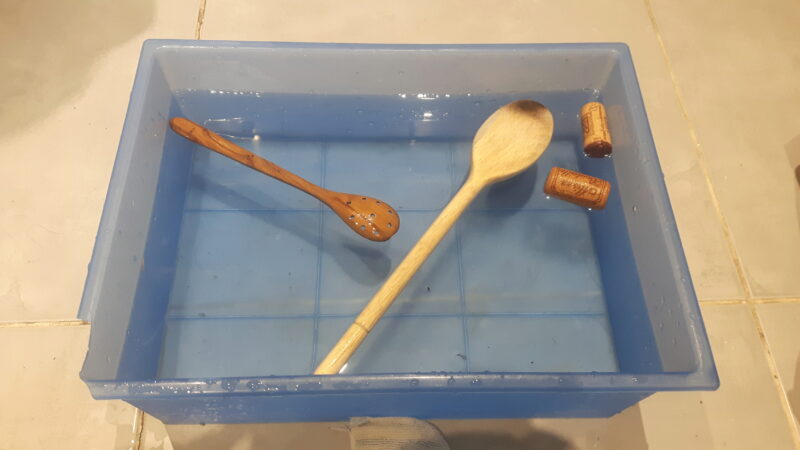
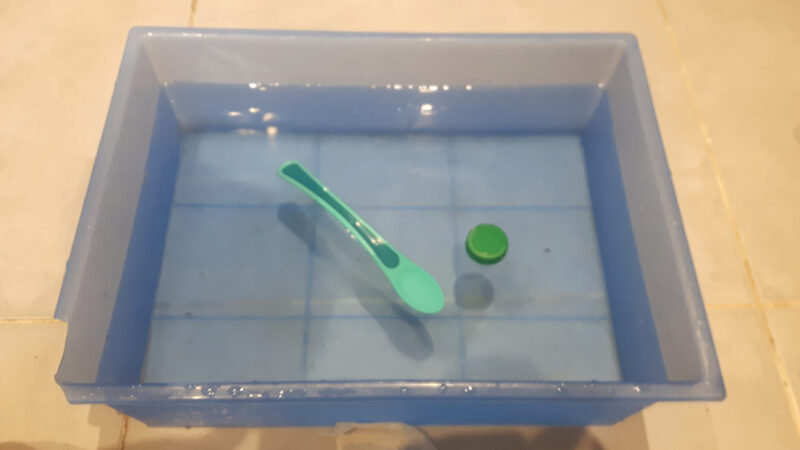
An object made out of a high-density material like metal or stone will sink, regardless of how small it is. Small pebbles and small metal bottle tops will sink, just as huge boulders do.
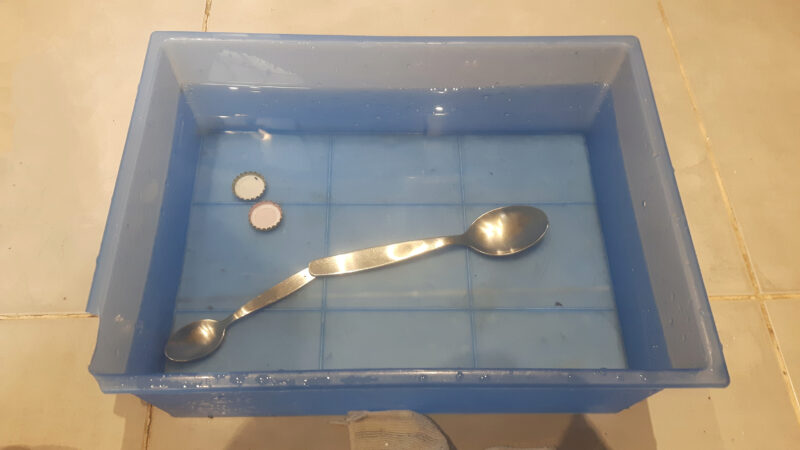

The reason is that, when you drop an object in water, the strength of the force pushing it upwards (it's bouyancy) depends only on how much water the object has pushed out of the way (displaced). As long as the bouyancy from the water pushes the object upwards harder than its weight pulls it downwards, the object will float. A big object has to push a lot of water out of the way. So it experiences a large bouyancy force pushing it upwards when it's dropped into water. This means a heavy object, like a big wooden spoon (or a tree trunk), may still float. Although it's heavy, its weight relative to its large size (its density) is still low. Whereas a small object, like a small pebble or a metal bottle top, may still sink. It may be fairly light, but it can still weigh a lot relative to its small size.
The concepts of density, bouyancy and displacement are almost certainly too complex to explain to children at this age. But the main thing that determines an object's density is what material it's made of. Metal and stone are dense. Wood and most plastics are not. Children at this age are often able to work out for themselves (maybe with some help), after seeing plenty of different examples, that they can tell whether an object will sink or float from the material it's made out of. Rather than whether the object is heavy or light or big or small. Objects made out of metal and stone sink. Wooden and (most) plastic objects float:
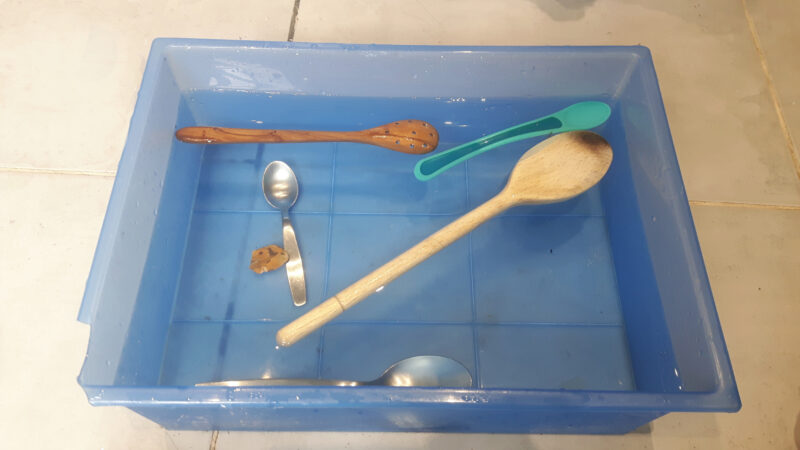
Different shapes
Displacement also explains why boats (and objects shaped like boats) float, but a different shape (such as a ball) made of the same material sinks. When the plasticine (or modelling clay) is shaped into a boat and placed in water, the boat shape pushes a lot of water out of the way. Even though the plasticine itself only forms the thin walls of the boat, water is pushed out of the way by the whole boat shape, including the empty space inside the boat. It pushes enough water out of the way that the force pushing the boat upwards (its bouyancy) is larger than the weight of the plasticine, so it floats:
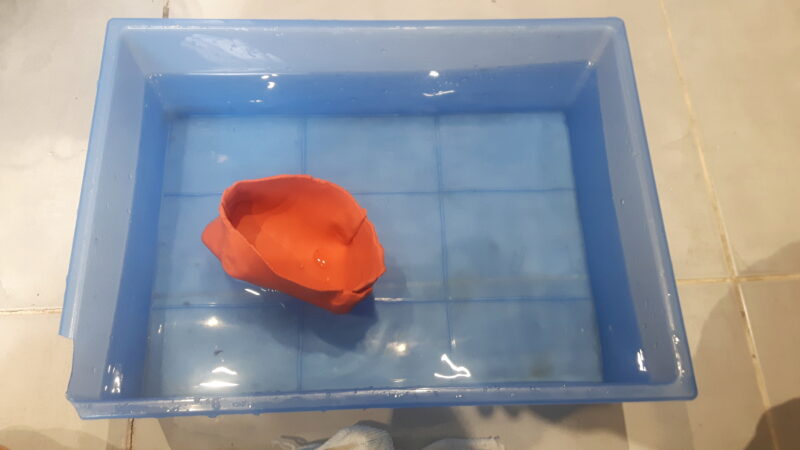
When the same plasticine is scrunched into a ball, the amout of water pushed out of the way is much smaller.

Now the bouyancy force pushing the plasticine upwards is less than the weight of the plasticine pulling it downwards, so the plasticine ball sinks to the bottom:
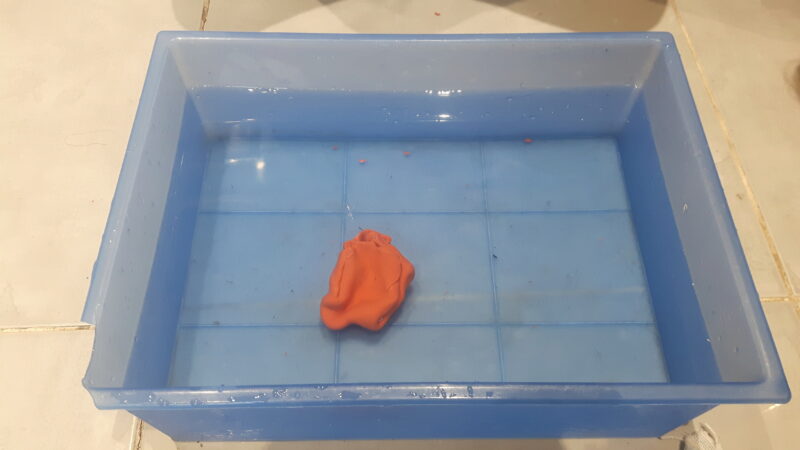
Again, this detailed explanation is almost certainly too complicated for children of this age. But young children are already able (perhaps with some help and prompting) to realise for themselves that it's not only what material an object is made out of that matters. When it comes to floating or sinking, the object's shape also matters. Plasticine shaped into a boat floats; the same plasticine shaped into a ball sinks.
Thinking like a scientist; working scientifically
Coming up with an explanation, then testing it
Despite the way it's often portrayed in films and books, scientific knowledge isn't created by a scientist having a stroke of genius, coming up with a great new idea, and adding their new piece of science to the textbooks. To come up with a possible explanation of what they've observed, scientists (and children!) observe many examples, and spot patterns that give them clues to possible explanations. Such as the fact that objects made of the same material do the same thing when dropped into water. Scientists call these initial possible explanations, "hypotheses".
But scientists don't just accept an explanation or hypothesis because it seems reasonable or because it's clever. The key step in science is the next one: testing the explanation, to see if it's right or not. It's perfectly reasonable to start off thinkig that heavy objects will sink, and light ones will float. That's what we see very often in our everyday experience. But when we test it by putting a big, heavy wooden spoon (or a tree trunk, or a huge ship) in water and see that it floats, we discover that this can't be the right explanation.
The idea that it's important to test the explanations we come up with, even if they seem reasonable and explain everything we've seen so far, is best taught by example.2 2To adults, just as much as to children! Floating and sinking might seem like a very simple experiment. Yet it's an ideal example of how to come up with initial explanations, and the importance of testing those explanations to find out if they're right or not.
Thinking about alternative explanations, and testing those
What if we'd started off putting a big, metal spoon (or a heavy stone, or a heavy ball of plasticine) in water and seen that it sinks? And then we'd tried a light plastic spoon (or a cork, or a plastic bottle top) and seen that it floats? We might well have concluded that our initial explanation was right: heavy objects sink and light ones float. Yet it's not!
Observations that seem to support our current explanation are less useful than observations that show us it's wrong. All it takes is one observation that doesn't match our explanation – like a heavy, wooden spoon floating – and we know for sure our explanation was wrong and we need to come up with a new one. Whereas it doesn't matter how many observations we've made that seem to support our current explanation – like big metal spoons, heavy stones, and heavy balls of plasticine all sinking, and light plastic spoons, corks, and plastic bottle tops all floating – our explanation could still be wrong.
That's why it's crucial to think of not just one possible explanation, but to come up with as many alternative explanations as we can think of, which could also explain everything we've observed so far. That way, we can think up new experiments to test those alternative explanations, and rule out the incorrect ones.3 3Since we can never be sure that we've thought of and tested every possible explanation, we can never be sure the explanation we're left with is correct. It could be that someone later comes up with a new explanation that explains everything we saw. tries a new experiment to test between our explanation and theirs, and discovers that our explanation was wrong all along. This has happened many times in the history of science. Scientific knowledge is always provisional, and it gets continually updated as we learn more. This is why no scientist will ever say they are completely certain they're right. No one ever honestly can say that; but scientists are generally more honest about their lack of certainty. However, the more different ways we have tested an explanation over years, decades and even centuries, the more confident we become that it's probably a good explanation. If we realise that everything we've seen so far could also be explained by the idea that metal, stone and plasticine sink, and wood, plastic and cork float, then we might think of trying a big, heavy, wooden spoon.
These concepts are certainly too abstract to explain to young children. But confronting them with evidence that goes against what they expect, and encouraging them to think about other ways of explaining what they've seen, is a very good start.4 4And probably already puts them ahead of many adults!
Variations
There are as many variations of this floating and sinking experiment as there are different objects you can find to drop into a bucket of water! Try to choose objects that provide a good range of different materials and sizes, so that you see enough different examples to start spotting patterns, which stimulate possible explanations for why some float and others sink for themselves.
Feedback
If you try this experiment with your own children, I'd be very happy to hear feedback on what worked well, what didn't work well, whether it was easy to follow, whether the explanations were clear, or anything else. I will continue to edit and improve this page over time. You can post public feedback on this page using the form below, or [[file:email.org][send me an email]].
Leave a comment
All comments are moderated. Clicking submit will open your email client and let you send your comment by email. By submitting your comment you agree to license the content under a Creative Commons Attribution-ShareAlike 4.0 International License.